Xatzis zaharoplasteia prepare 'politiki kouzina' creations - nearly all their recipes come from the Constantinople of former times, which is why the names of the specialties advertised on their billboards outside the shop sound very Turkish. They serve the full gamma of bougatsa, pites and traditional Greek syrup-drenched desserts, including one called Trigona Panoramatos, triangle-shaped pastries first made in the Thessaloniki suburb of Panorama by Asia Minor refugees who flooded into the city after the population exchange between Greece and Turkey in 1922.Our waitress was very knowledgeable, and explained a host of things to us about politiki kouzina.
Greece makes a wide range of filo pastry, but the most popular one is what's known as 'kroustas' (κρούστας), which gives a crusty but light finish to pies. It resembles cigarette paper in texture. There is also thicker filo pastry available, which is more often used in Crete than the crusty type. It is good for denser fillings which may not be able to withstand the weight of the thin type of pastry. You can get an idea of the various filo pastry varieties available in Greece here.
The difference in the thickness of the filo shows even here - the top sheet is thicker (and less transparent) than the bottom sheet
I chose my galaktoboureko recipe from the Chatzis website which includes a number of recipes in Greek for traditional sweets. The recipe sounded simple, which is what appealed to me initially, even if it was meant to be made in a large quantity, so I halved the original recipe and added a few twists of my own, which were necessitated when I ended up buying the wrong kind of pastry by accident - the packaging fooled me into thinking that I'd bought kroustas sheets, when in fact, I'd bought horiatiko! I thought I'd just ruined my galaktoboureko, but I can honestly say that it tasted better made with this variety of filo pastry. The only problem with this recipe is in the cleaning up afterwards: you will be using quite a few pots and pans...
To make the pie, you need:
450-500g of filo pastry (I used paradosiako/horiatiko, but you can use kroustas, which is the one usually used to make galaktoboureko, as in the photo on the Chatzis recipe)
200g butter (as the original recipe states: I used our own production of extra virgin olive oil - if you don't know what kind of olive oil you buy, then it's best to stick with butter, since you will need a lot and the taste of store-bought olive oil may not be as exquisite as my own local supplies)
750ml of milk
60g fine semolina
1/2 cup sugar
1 whole egg and 1 yolk
the grated zest of 1 lemon
2 vials of vanilla sugar (or 1 teaspoon of vanilla essence, whatever you have handy)
For the syrup, you need:
3 1/2 cups of water
2 1/2 cups sugar
1/2 cup lemon juice
2 tablespoons of honey
First place all the syrup ingredients in a small pot (number 1) and let them boil away for 15-20 minutes at high heat. The syrup will have cooled down slightly by the time it is needed. At this point, if you are using butter, melt it in a small saucepan (number 2 - now you can understand why I used olive oil instead).
While the syrup is being made, place the eggs, semolina and half the sugar in a larger pot (number 3) and mix them till well blended. Now place the milk, vanilla and remaining sugar in a saucepan (number 4 - and no more!) and heat them till the sugar has melted and the milk is very hot. Then pour the milk into the egg mixture, place this pot (not a new one!) on the element (at medium heat) to heat up, and keep beating quickly till the mixture is well-blended, thick and creamy. Turn off the heat and let the custard cool down.
Now grease a 20x30 pyrex dish or baking tin (at least it's not a saucepan!) and lay one sheet of filo over it in the centre, so that the edges overflow over the rims of the vessel. Generously brush butter or olive oil over the filo, but don't create a dripping effect! (If you were making the bigger version of this pie, as in the original recipe, you would use two overlapping sheets, greased in between, so that each sheet overflows on one side of the vessel.) Now lay another sheet of filo and repeat the process. You should use half the filo sheets in the packet for the bottom layer of the pie, which amounts to 6-7 when using kroustas filo or 3 when using horiatiko/paradosiako (as I did). The other half of the packet will be used for the top layer.
At this point, pour the custard into the pie. Smooth it down so that it has an even finish on the top. Now close all the extending pastry over the pie in a tidy way. Place a whole sheet of pastry over the pie and brush it with butter/olive oil. Repeat the process with the remaining sheets of pastry. Tidy up the edges of the top filo sheets and close the pie. With a sharp knife, score across the sheets before cooking - this will make cutting the cooked pie easier, as filo pastry (particularly the kroustas variety) tends to flake and break up easily. Place the pie in the oven and cook for about an hour in a moderate oven (180C).
When the pie is ready, bring it out of the oven and mark deep cuts into the pie, without lifting any piece out of the baking vessel. Then pour the syrup over the pie: listen for the whistling sound as the cool syrup splashes onto the hot custard! You may think that the syrup is too much for the pie, but this is because the pie soaks up the syrup gradually, so pour all the syrup over the pie. This dessert is hardly ever eaten warm, so when the pie is cooked, don't cut it until it has cooled down considerably, when it will also be more manageable to lift the pieces out of the baking dish.
Serve this pie with a glass of cool water - that's all it needs.
©All Rights Reserved/Organically cooked. No part of this blog may be reproduced and/or copied by any means without prior consent from Maria Verivaki.
200g butter (as the original recipe states: I used our own production of extra virgin olive oil - if you don't know what kind of olive oil you buy, then it's best to stick with butter, since you will need a lot and the taste of store-bought olive oil may not be as exquisite as my own local supplies)
750ml of milk
60g fine semolina
1/2 cup sugar
1 whole egg and 1 yolk
the grated zest of 1 lemon
2 vials of vanilla sugar (or 1 teaspoon of vanilla essence, whatever you have handy)
For the syrup, you need:
3 1/2 cups of water
2 1/2 cups sugar
1/2 cup lemon juice
2 tablespoons of honey
Before I placed the galaktoboureko into the oven, I scored the top layers of pastry with a knife. Filo pastry becomes quite crusty when cooked, and doesn't cut in a tidy way; scoring it before cooking makes things easier.
First place all the syrup ingredients in a small pot (number 1) and let them boil away for 15-20 minutes at high heat. The syrup will have cooled down slightly by the time it is needed. At this point, if you are using butter, melt it in a small saucepan (number 2 - now you can understand why I used olive oil instead).
While the syrup is being made, place the eggs, semolina and half the sugar in a larger pot (number 3) and mix them till well blended. Now place the milk, vanilla and remaining sugar in a saucepan (number 4 - and no more!) and heat them till the sugar has melted and the milk is very hot. Then pour the milk into the egg mixture, place this pot (not a new one!) on the element (at medium heat) to heat up, and keep beating quickly till the mixture is well-blended, thick and creamy. Turn off the heat and let the custard cool down.
Galaktoboureko out of the oven, drenched in syrup: this softens the filo and makes it easier to cut tidily.
Now grease a 20x30 pyrex dish or baking tin (at least it's not a saucepan!) and lay one sheet of filo over it in the centre, so that the edges overflow over the rims of the vessel. Generously brush butter or olive oil over the filo, but don't create a dripping effect! (If you were making the bigger version of this pie, as in the original recipe, you would use two overlapping sheets, greased in between, so that each sheet overflows on one side of the vessel.) Now lay another sheet of filo and repeat the process. You should use half the filo sheets in the packet for the bottom layer of the pie, which amounts to 6-7 when using kroustas filo or 3 when using horiatiko/paradosiako (as I did). The other half of the packet will be used for the top layer.
Within a few hours, the syrup seen in this photo was soaked up by the remaining pie.
At this point, pour the custard into the pie. Smooth it down so that it has an even finish on the top. Now close all the extending pastry over the pie in a tidy way. Place a whole sheet of pastry over the pie and brush it with butter/olive oil. Repeat the process with the remaining sheets of pastry. Tidy up the edges of the top filo sheets and close the pie. With a sharp knife, score across the sheets before cooking - this will make cutting the cooked pie easier, as filo pastry (particularly the kroustas variety) tends to flake and break up easily. Place the pie in the oven and cook for about an hour in a moderate oven (180C).
My photography skills were lacking when I took this photo of a serving of galaktoboureko, but I'll let you imagine its taste...
When the pie is ready, bring it out of the oven and mark deep cuts into the pie, without lifting any piece out of the baking vessel. Then pour the syrup over the pie: listen for the whistling sound as the cool syrup splashes onto the hot custard! You may think that the syrup is too much for the pie, but this is because the pie soaks up the syrup gradually, so pour all the syrup over the pie. This dessert is hardly ever eaten warm, so when the pie is cooked, don't cut it until it has cooled down considerably, when it will also be more manageable to lift the pieces out of the baking dish.
Serve this pie with a glass of cool water - that's all it needs.
©All Rights Reserved/Organically cooked. No part of this blog may be reproduced and/or copied by any means without prior consent from Maria Verivaki.
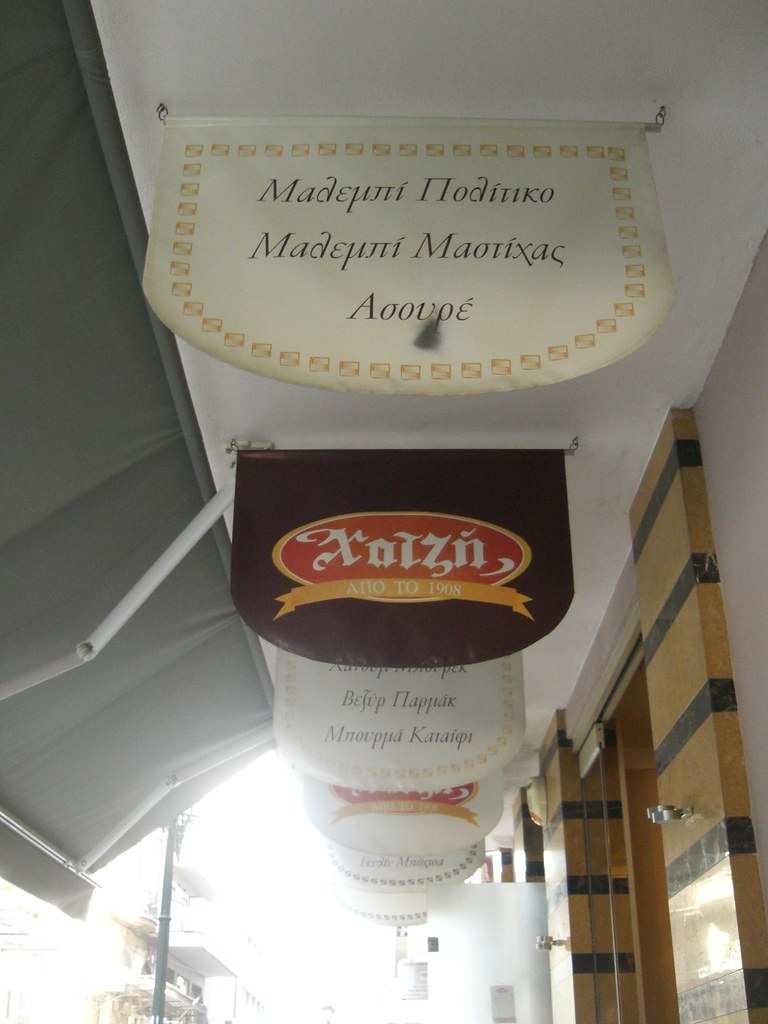

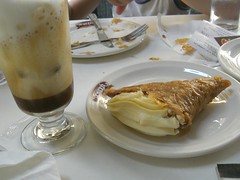
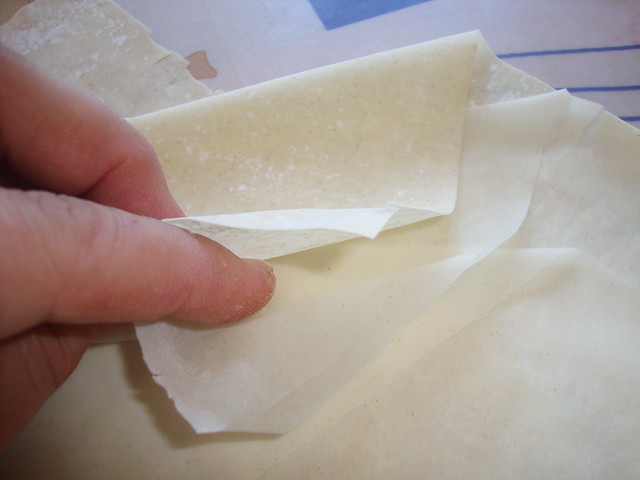
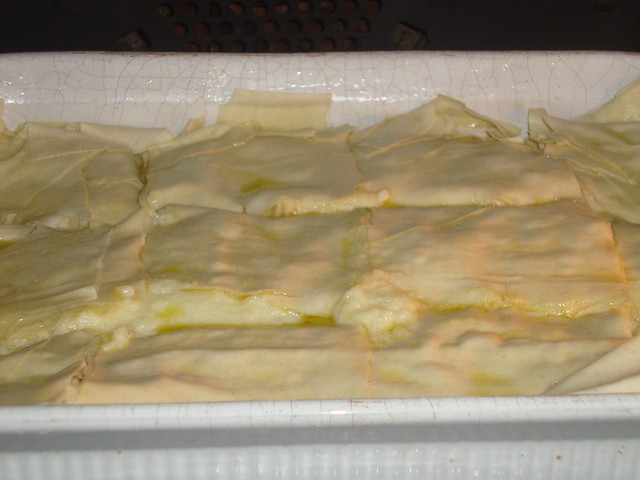
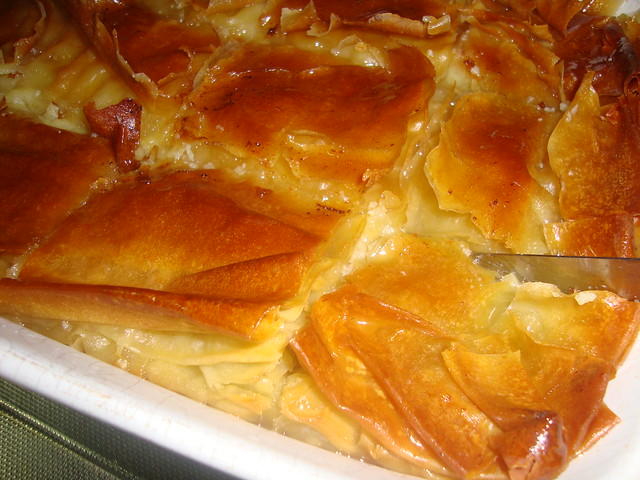
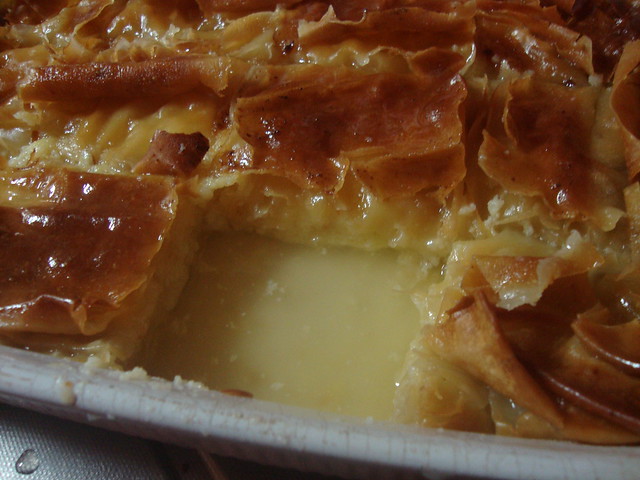

It looks creamy and satisfying Maria. I would love the have a slice right now.
ReplyDeleteIt looks great Maria! I don't often make galaktoboureko because I will likely eat the better part of the pan myself. Everyone in the family loves it by I've got a more pronounced sweet tooth.
ReplyDeleteAww, you have ignited my special "galaktoboureko" fuse , Maria..I, also, hardly ever make it because it will be levelled by yours truly..haha..I suppose I'll have to try it REALLY soon..Have a great evening!
ReplyDeleteΈνα από τα πιο αγαπημένα μου γλυκά. Όταν το έγραψες στο φβ, είδα τη συνταγή του Χατζή, την οποία θεωρώ πολύ καλή και μοιάζει πολύ με της μάνας μου! Καλό μήνα!
ReplyDeleteNice detailed instructions Maria. I had no idea that there were different types of filo available! (I'm sure here they only sell one type at the supermarket and deli's). I've been itching to have a go at this myself and maybe throw in a few other flavours. Thank you for the inspiration!
ReplyDeleteIt looks so delicious and inviting!
ReplyDeleteHere I'm reminded again that I need to learn to make filo pastry... or at least try and find a decent quality one!
galaktoboureko is one of my most favorite things in the world! I also hit up Xatis last time I was in Athens. Too bad lent has started! Wah wah wah. BUT maybe a vegan version could be made. I wish I could try some of your olive oil!
ReplyDeleteThanks so much for this recipe. It turned out perfect!!!
ReplyDelete